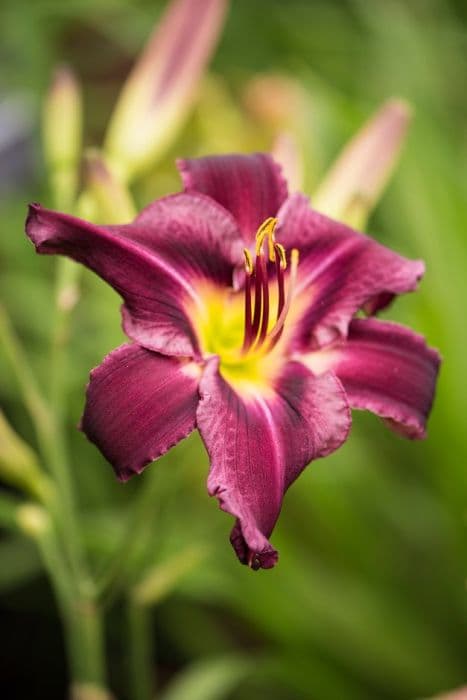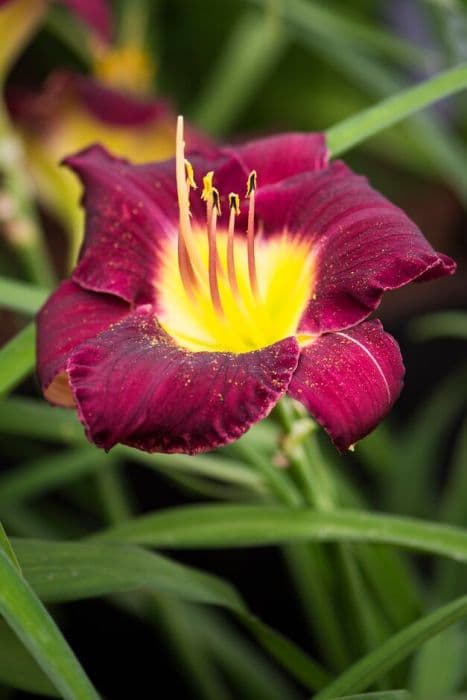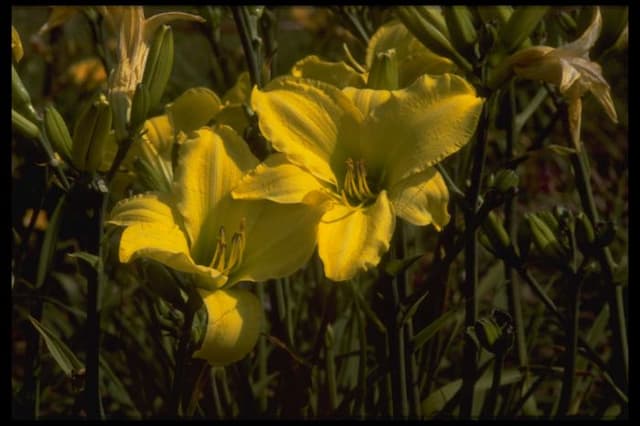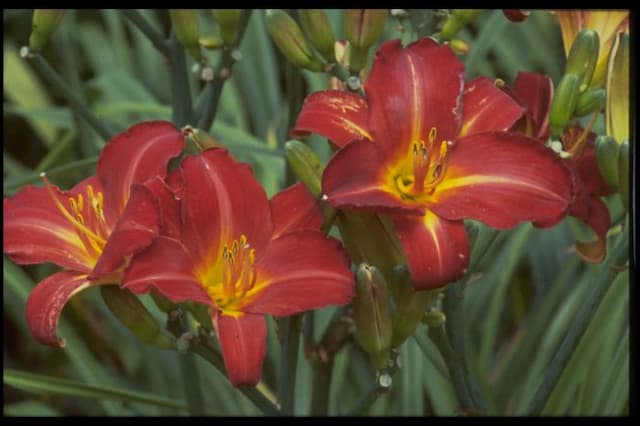Daylily Hemerocallis 'Tuxedo Whiskers'

ABOUT
Hemerocallis 'Tuxedo Whiskers' is commonly known as a Daylily. This cultivar exhibits a distinctive floral display with blooms characterized by their rich, velvety dark purple color, almost appearing black in certain lights. The petals are broad and slightly ruffled on the edges, adding to their lush appearance. The striking flowers often feature a contrasting lime-green throat, providing a vivid pop of color at the center. Each flower, typical of Daylilies, only lasts for a day, with new blooms constantly replacing the spent ones during the plant's blooming season. The foliage of 'Tuxedo Whiskers' consists of long, arching, strap-like leaves that are a fresh green color, forming a dense clump from which the flower scapes emerge. The leafy backdrop contrasts nicely with the dramatic coloring of the flowers, emphasizing their bold hues. This Daylily's overall elegant yet sturdy form makes it a popular choice for gardeners looking to add a touch of dramatic flair to their flower beds or borders. It is generally known for its low maintenance and good resistance to many garden pests and diseases.
About this plant
 Names
NamesFamily
Asphodelaceae
Synonyms
Daylily
Common names
Hemerocallis 'Tuxedo Whiskers'
 Toxicity
ToxicityTo humans
The plant Daylily (Hemerocallis 'Tuxedo Whiskers') is generally considered non-toxic to humans. In fact, certain parts of daylilies are edible and have historically been consumed in various cultures. However, it is always crucial to be certain of the plant identity and its edibility because mistaking other lily varieties for daylilies can lead to accidental poisoning, as some lilies are highly toxic. If another toxic lily plant is mistakenly ingested, symptoms could include nausea, vomiting, abdominal pain, and in severe cases, kidney failure or death.
To pets
Daylilies are toxic to cats. If a cat ingests any part of the Daylily, it can cause severe symptoms such as vomiting, lethargy, kidney failure, and in some cases, it can be fatal. The exact toxic compound in daylilies responsible for this toxicity is not well understood, but it is imperative to prevent cats from accessing any parts of the plant. Prompt veterinary attention is crucial if a cat is suspected to have ingested daylilies.
 Characteristics
CharacteristicsLife cycle
Perennials
Foliage type
Deciduous
Color of leaves
Green
Flower color
Mixed
Height
2 feet [61 cm]
Spread
2 feet [61 cm]
Plant type
Herb
Hardiness zones
4-9
Native area
Asia
Benefits
 General Benefits
General Benefits- Easy to grow: The daylily 'Tuxedo Whiskers' is known for being adaptable to a variety of soil conditions and is generally low-maintenance.
- Drought tolerance: Once established, this plant has good resistance to periods of low water availability.
- Landscape versatility: Its attractive flowers and foliage make it suitable for borders, flower beds, and mass plantings.
- Long blooming period: This cultivar typically has a long flowering season, providing color and interest throughout the summer.
- Pest resistance: Daylilies have a natural resistance to many pests, reducing the need for chemical treatments.
- Attracts pollinators: The blooms attract butterflies and bees, which are beneficial for pollination in the garden.
- Diverse color and form: 'Tuxedo Whiskers' offers unique flowers with distinctive coloring that can add aesthetic appeal to any garden space.
- Propagates easily: Daylilies can be easily divided to propagate new plants for expanding the garden or sharing with friends and fellow gardeners.
 Medical Properties
Medical PropertiesThis plant is not used for medical purposes.
 Air-purifying Qualities
Air-purifying QualitiesThis plant is not specifically known for air purifying qualities.
 Other Uses
Other Uses- Edible Landscaping: Daylilies can be planted for both their aesthetic appeal and as a source of edible flowers and buds, adding visual interest and culinary opportunities to gardens.
- Companion Planting: They can be used as companion plants in vegetable gardens to attract pollinators and potentially deter certain pests.
- Floral Crafts: The sturdy, colorful flowers of the Daylily can be used in crafting, such as creating floral arrangements or pressing flowers for art.
- Dye Production: The flowers can be used to make natural dyes for coloring fabrics, yarns, and other materials.
- Soil Erosion Control: With their dense root systems, Daylilies can be planted on slopes or areas prone to erosion to help stabilize the soil.
- Gastronomic Events: Daylilies could be the centerpiece of garden-to-table events or cooking classes focusing on edible flowers.
- Photography Subject: Because of their unique appearance, Daylilies make excellent subjects for botanical photography and art.
- Stormwater Management: They can be utilized in rain gardens to manage runoff, as they can tolerate occasional waterlogging and help in water infiltration.
- Mood Enhancement: Being around flowering plants like Daylilies has been shown to improve mood and decrease stress, without the need to attribute this to air purification.
- Thematic Gardening: Daylilies can be featured in theme gardens, such as black-and-white gardens, where their 'Tuxedo Whiskers' variety can complement the theme with its color patterns.
Interesting Facts
 Feng Shui
Feng ShuiThe Daylily is not used in Feng Shui practice.
 Zodiac Sign Compitability
Zodiac Sign CompitabilityThe Daylily is not used in astrology practice.
 Plant Symbolism
Plant Symbolism- Daylily: The most common name for Hemerocallis 'Tuxedo Whiskers' is Daylily. Traditionally, Daylilies symbolize motherhood and fertility because of their ability to produce numerous offspring – in this case, a multitude of flowers.
- Transience: The Daylily is also a reminder of the fleeting nature of life, as each blossom tends to only last for a day before being replaced by another.
- Beauty: With its graceful blooms, the Daylily represents the idea that beauty is temporary, encouraging us to appreciate the present moment.
- Forgetfulness: In the language of flowers, or floriography, Daylilies can sometimes stand for forgetfulness or a loss of memory, likely due to the short lifespan of its individual flowers.
- Survival: Daylilies are extremely hardy and adaptable, often symbolizing the ability to overcome challenges and survive in difficult circumstances.
- Rebirth: Reflecting the cycle of rebirth and renewal, Daylilies can symbolize a fresh start or a new beginning thanks to their daily cycle of blooming afresh.
 Water
WaterDaylilies, including Hemerocallis 'Tuxedo Whiskers', should be watered deeply once a week, providing about 1 inch of water which equates to about 0.623 gallons per square foot. During hot, dry spells, watering may need to increase to twice per week. The soil should be allowed to dry out slightly between waterings to prevent waterlogging. Water at the base of the plant to keep the foliage dry and reduce the risk of disease. It's essential not to overwater, as daylilies do not like to sit in waterlogged soil.
 Light
LightDaylilies prefer full sun to bloom their best, which means Hemerocallis 'Tuxedo Whiskers' should receive at least six hours of direct sunlight each day. This plant can tolerate partial shade, especially in hot climates, where some afternoon shade can protect it from the most intense sun. The best spot for this plant is an area that receives morning sunlight and partial shade during the hottest part of the day.
 Temperature
TemperatureDaylilies thrive in a variety of temperature conditions; Hemerocallis 'Tuxedo Whiskers' prefers temperatures between 60 and 90 degrees Fahrenheit for optimal growth. They can survive minimum temperatures down to about -30 degrees Fahrenheit, making them hardy in many climates. Ensuring proper mulching can help protect the plant in colder temperatures and maintain a more consistent root temperature.
 Pruning
PruningPrune Hemerocallis 'Tuxedo Whiskers' to remove spent flowers and stalks to encourage new blooms and to keep the plant looking tidy. Cut back foliage in late fall or early spring to clean up the garden and remove any dead or damaged tissue. Division of the plants every few years is recommended to maintain vigor and flower quality. The best time to prune and divide is after the plant has finished blooming.
 Cleaning
CleaningAs needed
 Soil
SoilThe best soil mix for daylilies (Hemerocallis 'Tuxedo Whiskers') is well-draining, fertile loam with ample organic matter. A pH of 6.0 to 6.5 is ideal for these plants to thrive.
 Repotting
RepottingDaylilies (Hemerocallis 'Tuxedo Whiskers') generally do not require frequent repotting; they can be divided and repotted every 3-5 years to maintain vigor and prevent overcrowding.
 Humidity & Misting
Humidity & MistingDaylilies (Hemerocallis 'Tuxedo Whiskers') are adaptable but prefer moderate ambient humidity, avoiding excessively dry or overly humid conditions for optimal growth.
 Suitable locations
Suitable locationsIndoor
Ensure bright light, and well-draining soil for indoor daylilies.
Outdoor
Plant in sun to part-shade, well-draining soil, space adequately.
Hardiness zone
3-9 USDA
 Life cycle
Life cycleHemerocallis 'Tuxedo Whiskers', commonly known as a variety of Daylily, begins its life cycle when a seed germinates in moist, well-drained soil, typically in late winter or early spring. After germination, the seedling grows into a juvenile plant, developing a clump of grass-like foliage and a root system. As the plant matures, it enters the vegetative stage, where it increases in size and produces more foliage, preparing for flowering. The daylily reaches reproductive maturity usually within a few years, leading to the blooming stage in early to mid-summer, where it produces distinctive flowers that usually last just one day before withering. Once pollinated, the flowers will develop into seed pods if conditions allow; otherwise, the plant may propagate vegetatively through division of the root clump. After flowering, the daylily enters a period of senescence in late autumn, where foliage dies back with the onset of colder temperatures, though the roots remain alive through winter to begin the cycle anew in the spring.
 Propogation
PropogationPropogation time
Spring to Summer
The most popular method of propagating the daylily 'Tuxedo Whiskers' is by division. This is typically done in the early spring or after the flowering period in the late summer to early fall. To propagate by division, carefully dig up the clump of daylilies, using a shovel to loosen the soil. Once the clump is out of the ground, gently pull or cut the clump into smaller sections, each with a few fans of leaves and a portion of the root system. Replant the divisions at the same depth they were growing at previously, allowing about 18 to 24 inches (approximately 45 to 60 cm) between each plant to ensure adequate space for growth. Water the newly planted divisions well to help establish their roots in the new location. This method allows gardeners to quickly increase their stock of 'Tuxedo Whiskers' daylilies while maintaining the health and vigor of their plants.









